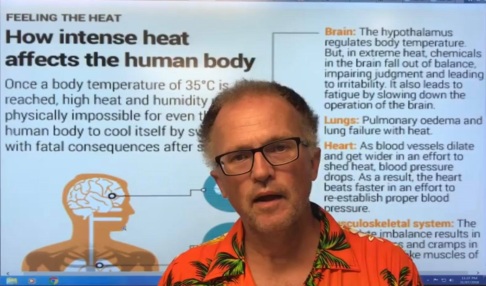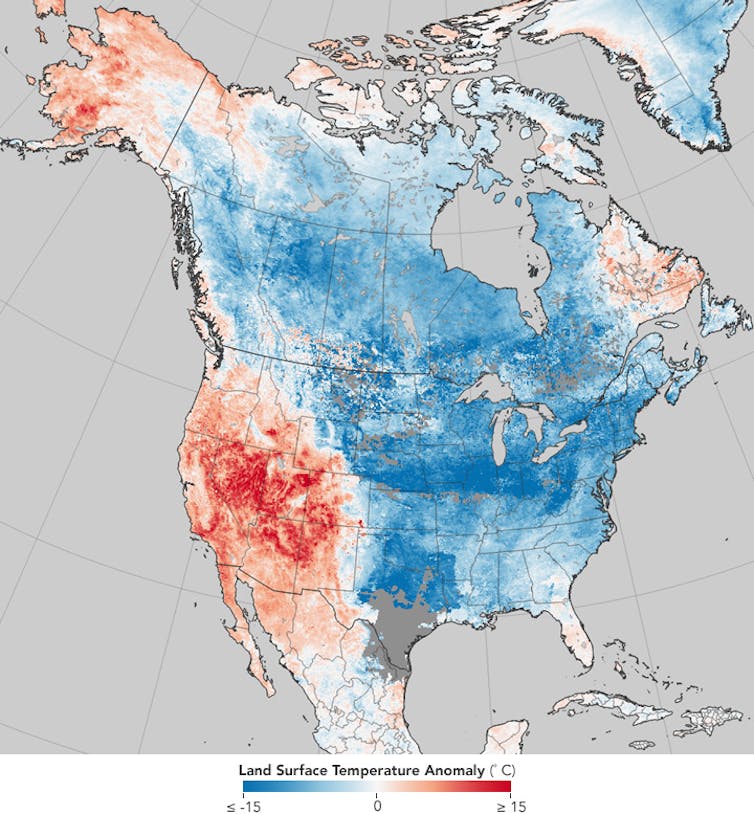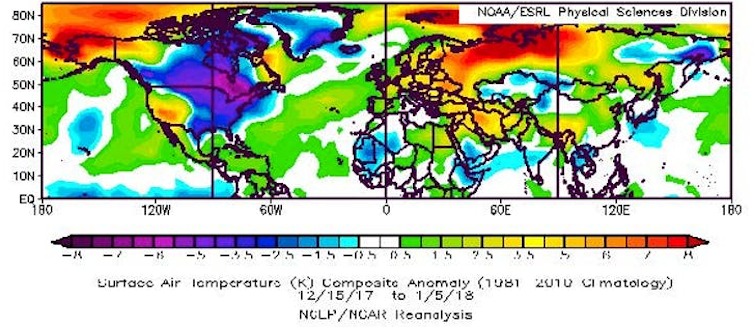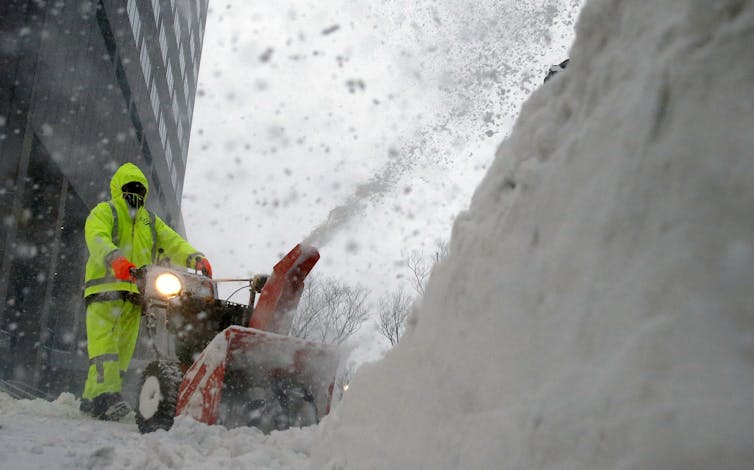When calculating how much warmer we can expect it to get, climate models typically use linear projections based on temperature averages, such as annual global average temperatures, daily temperatures that are averages between day and night, etc. Sadly, this downplays the danger, as average temperatures are unlikely to kill people. When lives are at stake, peaks matter!
Where are temperatures rising most?
Temperatures are rising most strongly in the Arctic. Above map shows a rise of as much as 5.7°C or 10.26°F in Arctic.
Ocean heat on the move toward Arctic Ocean
The image below shows that the sea surface was 22°C or 71.6°F on August 13, 2018, at 77.958°N, 5.545°E (near Svalbard), i.e. 6.9°C or 12.4°F warmer than 47 days earlier and 16.4°C or 29.5°F warmer than it was during 1981-2011.
Local maximum temperatures can be good indicators for the maximum heat stress that can be expected in the area.
As illustrated by above image, the sea surface near Svalbard was 22°C or 71.6°F at the green circle on August 13, 2018, i.e. 16.4°C or 29.5°F warmer than 1981-2011.
 This high sea surface temperature is an indicator of the temperature of the water below the surface, which in turn is an indicator of the amount of ocean heat that is entering the Arctic Ocean from the Atlantic Ocean.
This high sea surface temperature is an indicator of the temperature of the water below the surface, which in turn is an indicator of the amount of ocean heat that is entering the Arctic Ocean from the Atlantic Ocean. Ocean heat is carried by the Gulf Stream from the North American coast toward the Arctic Ocean, as illustrated by the images below and on the right.
Warming of the Arctic Ocean comes with a number of feedbacks that accelerate this warming, such as albedo changes that take place as the Arctic snow and ice cover declines, and methane that is released from sediments containing methane in the form of hydrates and free gas.
The situation could get worse rapidly. As an example, with a decrease in cooling aerosols, which are concentrated in the Northern Hemisphere, the North Atlantic looks set to absorb more heat. A recent study calculated that the North Atlantic’s share of the uptake could increase from 6% to about 27%.
As another example, a recent study concludes: Existing models currently attribute about 20% of the permafrost carbon feedback this century to methane, with the rest due to carbon dioxide from terrestrial soils. By including thermokarst lakes, methane becomes the dominant driver, responsible for 70% to 80% of permafrost carbon-caused warming this century. Adding thermokarst methane to the models makes the feedback’s effect similar to that of land-use change, which is the second-largest source of manmade warming.
High methane levels warn about seafloor methane releases
 The image on the right illustrates the danger, showing high methane levels at Barrow, Alaska, in July 2018.
The image on the right illustrates the danger, showing high methane levels at Barrow, Alaska, in July 2018.When making projections of heat stress, it is important to look at all potential warming elements, including albedo changes, changes to jet streams and sea currents, higher levels of methane, high levels of water vapor, etc.
 Methane is a potent greenhouse gas, causing huge warming immediately after entering the atmosphere, while this warming will be felt most strongly where the methane was released. Methane can therefore contribute strongly to local temperature peaks.
Methane is a potent greenhouse gas, causing huge warming immediately after entering the atmosphere, while this warming will be felt most strongly where the methane was released. Methane can therefore contribute strongly to local temperature peaks.On August 6, 2018, mean global methane levels were as high as 1896 ppb. On August 8, 2018, they were as high as 1898 ppb.
Importantly, peak levels on the afternoon of August 6, 2018, were as high as 3046 ppb, as illustrated by the image on the right. The likely origin of those high levels is the Arctic Ocean, which should act as a stark warning of things to come.
Further contributors to heat stress
Next to temperature, humidity is of vital importance. A combination of high temperatures and high humidity is devastating.
A recent study shows that the risk of deadly heat waves is significantly increased because of intensive irrigation in specific regions. The study points at a relatively dry but highly fertile region, known as the North China Plain — a region whose role in that country is comparable to that of the Midwest in the U.S. That increased vulnerability to heat arises because the irrigation exposes more water to evaporation, leading to higher humidity in the air than would otherwise be present and exacerbating the physiological stresses of the temperature.
The image below shows a forecast of perceived temperatures in China on August 7, 2018.
 The green circle highlights an area that is forecast to score high on the 'Misery Index' and that is centered around a location on the coast of Poyang Lake, which is connected to the Yangtze River. Temperatures there are forecast to be as high as 36.4°C or 97.4°F. At first glance, this may not look very high, but a relative humidity 68% is forecast to make it feel like 54.1°C or 129.3°F. This translates into a wet-bulb temperature of 31.03°C or 87.86°F.
The green circle highlights an area that is forecast to score high on the 'Misery Index' and that is centered around a location on the coast of Poyang Lake, which is connected to the Yangtze River. Temperatures there are forecast to be as high as 36.4°C or 97.4°F. At first glance, this may not look very high, but a relative humidity 68% is forecast to make it feel like 54.1°C or 129.3°F. This translates into a wet-bulb temperature of 31.03°C or 87.86°F.The image on the right shows relative humidity. Also note the cyclones lined up on the Pacific Ocean. Cyclones can increase humidity, making conditions worse.
The high sea surface temperature anomalies that are common in the West Pacific (image right) contribute to warmer air and stronger cyclones carrying more moisture toward Asia, as discussed in this facebook thread which also features the next image on the right, showing that cyclone Soulik is forecast to cause waves as high as 18.54 m or 60.8 ft near Japan on August 20, 2018.
 If humidity kept rising, a temperature of 36.4°C at a relative humidity of 91% would result in a wet-bulb temperature of 35°C. No amount of sweating, even in the shade and in front of strong winds or a fan, can cool the body under such conditions, and it would be lethal in a matter of hours in the absence of air conditioning or cold water.
If humidity kept rising, a temperature of 36.4°C at a relative humidity of 91% would result in a wet-bulb temperature of 35°C. No amount of sweating, even in the shade and in front of strong winds or a fan, can cool the body under such conditions, and it would be lethal in a matter of hours in the absence of air conditioning or cold water.There are further factors that can contribute to make specific areas virtually uninhabitable. The urban heat effect is such a factor. El Niño is another one. Land-only temperature anomalies are higher than anomalies that are averaged for land and oceans. As temperatures keep rising, heat waves can be expected to intensify, while their duration can be extended due to jet stream blocking.
The situation is dire and calls for comprehensive and effective action as described in the Climate Plan.
Below, Paul Beckwith warns that parts of the world 'will soon be rendered uninhabitable'.
Video: Unrelenting Heat, Humidity Will Soon Make Regions UNINHABITABLE
Paul Beckwith: "How hot can it actually get? What is in store for us? When you combine the heat domes sitting over many countries with high humidity, many areas around the planet will soon reach the deadly 35°C (95°F) 100% humidity (wet bulb temperature) or equivalent situation whereby a perfectly healthy person outside, in a well ventilated area, in the shade will die from the heat in 6 hours."
Video: Most Mammals Endure Heat Waves Better Than Humans
"Most people, like the very young, the elderly, and the rest of us won’t last anywhere as long, at even lower temperatures. I discuss the latest peer-reviewed science on how parts of high-risk regions in the North China Plains, Middle East, and South Asia will soon be rendered uninhabitable by combined heat and humidity."
Video: Uninhabitable Regions with Extreme Heat and Humidity
Also watch this video, in which Guy McPherson talks about the way aerosols currently mask the full wrath of global warming.
Video: Edge of Extinction: Rate Matters
Above video is also incorporated in the video below.
Video: McPherson's Paradox
and for the bigger picture, also watch the video below.
Video: Responding to Abrupt Climate Change with Guy R. McPherson
Links
• It could be unbearably hot in many places within a few years time
https://arctic-news.blogspot.com/2016/07/it-could-be-unbearably-hot-in-many-places-within-a-few-years-time.html
• Feedbacks
https://arctic-news.blogspot.com/p/feedbacks.html
• Latent Heat
https://arctic-news.blogspot.com/p/latent-heat.html
• How much warming have humans caused?
https://arctic-news.blogspot.com/2016/05/how-much-warming-have-humans-caused.html
• The Threat
https://arctic-news.blogspot.com/p/threat.html
• Extinction
https://arctic-news.blogspot.com/p/extinction.html
• Climate Plan
https://arctic-news.blogspot.com/p/climateplan.html

















































